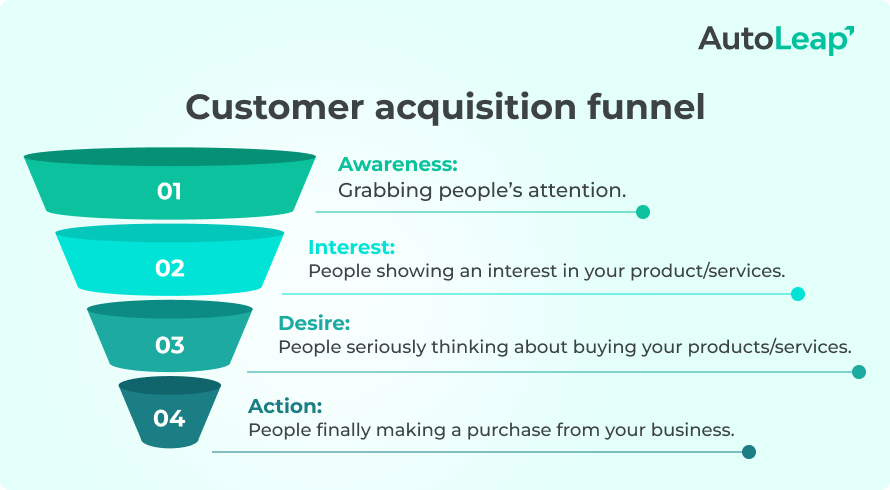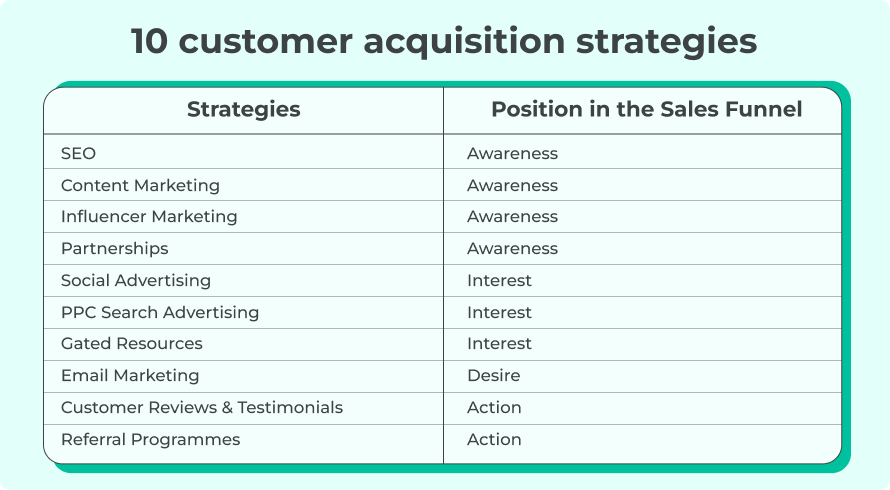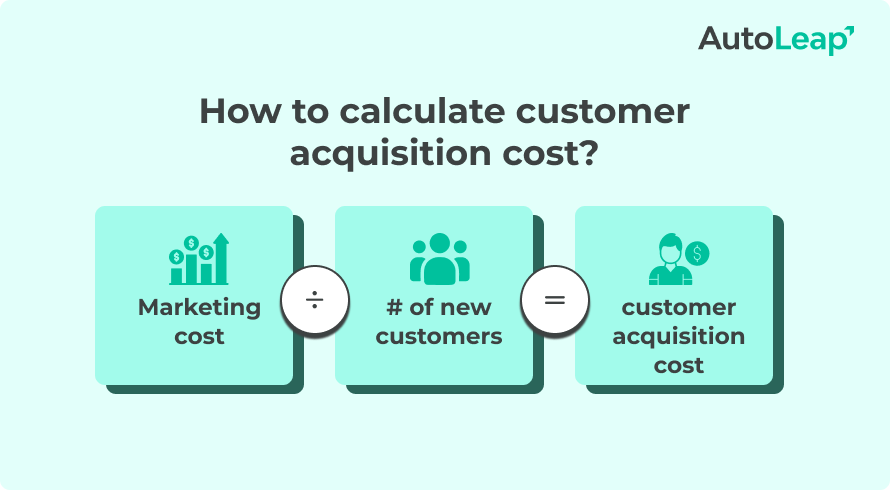Have you just started your own business? Or are you looking to expand your customer base? Whatever the case, customer acquisition is important for growth.
Welcome to our blog on customer acquisition strategies for small businesses. Here, you will find everything about customer acquisition, from discovering efficient ways to attract new customers to keep existing sales flowing.
Schedule a free demo today!

Boost your shop sales

Simplify shop management

Empower your technicians
What is customer acquisition?
It is the process of acquiring new customers to buy your products or services. It begins by attracting potential customers. Then you guide them through the journey and make them interested in what you offer. Lastly, you convince them to make a purchase. The total cost you spend in this process is known as the customer acquisition cost (CAC).
Let’s make this easier by breaking it down with an example.
Now imagine you run an auto repair shop. What will customer acquisition for your shop look like? Here’s how it plays out:
- Attract leads: Think of leads as potential customers that are interested in your services and may become paying customers in the future. You can catch their attention by posting ads in the local newspaper or sharing content on social media. These ads attract clients who are looking for car repair services. They can then become potential customers or “leads” for your shop.
- Nurture leads: If a lead shows interest by clicking on your ad or visiting your website, you would want to keep them interested. You can do that through helpful features like easy appointment bookings or a list of services you provide. This helps potential customers learn more about your expertise.
- Convert leads: When a lead decides they need their car fixed, you want them to choose your shop. You can offer a special deal for first-timers or make sure your customer service is top-notch when they call to book an appointment. These little extras can convince people to pick your shop over others and become happy paying customers.
Difference between customer acquisition and marking
Let’s start with what marketing is. For instance, you decide to throw a new years party. Now you invite your friends and family to your party (your business) by putting out invites (your ads) on socials. You can then observe and track how many people responded with a yes or no response. You can also see who liked or commented on it and how many are sharing the post. That’s your marketing at work: it’s all about making people aware and excited about your party.
Now, customer acquisition is what happens when people actually decide to come to your party. It’s like this: once they’ve seen your invite, what do they do about it? Maybe they clicked on your ad, landed on your website, or read your social post? If they dig what they see and decide to buy your product or service, that’s a win for customer acquisition.
Think of it like this: marketing is spreading the word about your party, and customer acquisition is what gets people actually to come to the party. So, to sum it up, marketing gets you noticed, and customer acquisition turns that notice into action, filling your party with guests who are ready to enjoy what you’ve got to offer and, importantly, bring in the revenue.
Key benefits of customer acquisition strategies
Let’s use an example of a lemonade stand. If you are running this stand, then you won’t sit around and wait for people to come to you, right? You’ve got to call out, “Hey, come grab your lemonade!” That is what a plan to get new customers is all about.
Now, let’s see why it is important and what benefits you get out of it.
- Improved ROI: When you focus on specific campaigns, markets, and channels, you’ll likely see higher value and conversion rates. This means you’re getting better value for the money you spend. For example, if you set up your lemonade stand at a busy park instead of a quiet street, you’ll probably sell more cups.
- Smart use of resources: With a clear plan, you can use your time and money wisely on tasks and campaigns that work. Over time, you’ll figure out which channels bring in the most customers so you can spend less on ones that don’t work as well. For instance, if most people just want a simple plastic one, you wouldn’t spend all your cash on fancy lemonade cups.
- Track progress: Connecting leads and conversions to sales data, you can easily see how well your efforts are paying off. This lets you know if your strategies are working or not. It’s like keeping score in a game – you know if you win or lose.
- Understand your market: By monitoring your campaigns, you can learn a lot about your customers and what they like. For instance, paying attention to who buys your lemonade and when they buy it helps you make decisions about your business to make even more people happy.
Customer acquisition funnel
The customer acquisition funnel is like a roadmap for potential customers. It helps you understand how people go from hearing about your business to buying something from you, and even beyond.
Imagine a funnel you’d use in the kitchen, wide at the top and narrow at the bottom. This funnel has a few important stages:

- Awareness: The funnel is wide at the initial stage of awareness. It’s the starting point of the roadmap where you grab people’s attention. You can do this by posting ads or social media posts to get more people to know about your brand.
- Interest: This is a stage where you will filter out the people who are interested in what you are offering because not everyone will be. These will be potential leads who are interested in what you offer because they may want or need that.
- Desire: The funnel at this stage starts to get narrower. These are a group of people who are now seriously thinking about buying from you. They have shown a desire by clicking on that ad or by going to your webpage.
- Action: The final stage is when a potential lead finally takes action and makes the purchase from you. They have now become a paying customer.
What is digital acquisition marketing?
Digital acquisition marketing is all about using online (digital) platforms to find new customers. This is usually done by a collaborative effort between your marketing and customer service teams.
You must be wondering how that works. Your marketing team first creates attention-grabbing ads and creative social media posts. Their goal is to attract customers to interact with your business. But it’s your customer service team that is directly communicating with your current customers (and these current customers can be some of the best marketers).
When the marketing team successfully lands visitors on the website, they may decide to buy your product or service. However, using the website’s live chat feature, they can communicate directly with the customer service team. If a potential customer reaches out through social media, they will most likely speak to one of your customer service team members. Hence, the customer service team has the same ability to bring new potential customers and convince them to become paying customers.
Both teams play a crucial part in acquiring customers. Before we dive into how you can keep the converted customers happy, let’s take a look at some of the common channels to attract them.
Common customer acquisition channels
These are the different channels through which you can reach out to broader audiences:
- Organic search: This is about showing up in search engine results when people search for something you offer. This can be done by making your website or content climb to the top of search results through search engine optimization.
- Paid search: Unlike organic search, paid search means you can pay to be seen in the search results. You can do this through paid ad campaigns that can appear alongside search results. This increases your chances of getting noticed.
- Organic social media: Social media platforms can help boost your brand’s visibility and share content without paying. It’s great for building a community around your brand and getting customers to spread the word.
- Paid social media: When you pay for ads on social media, your business gets a boost in visibility. For example, Facebook, Instagram, Snapchat, etc offer targeted ad options that can get your content in front of your target audience.
- Email Marketing: You can collect emails from various sources like your website or interactive social campaigns. These emails will let you reach directly to your potential customers. It can be super effective for promoting new products or services, sharing discounts, or for simply keeping the potential customers engaged.
- Referrals: There is no better marketing than word of mouth. You can encourage your existing customers to refer others to you through incentives such as discounts or gifts.
- Traditional Advertising: This includes old-school channels like TV, radio, or newspapers. If your target audience is a less digitally savvy audience, these can be really effective, especially when you combine them with modern channels.
10 customer acquisition strategies

1. SEO
SEO helps more people find your website when they search for things related to your business on Google. By using the right keywords, making your website faster, and organizing the information clearly, you increase the chances of your website appearing on top when someone searches for any of the product or service you offer.
If you run a pet store, you’d use SEO to make sure when people in your area look up “best puppy food,” your website pops up. The higher you rank, the more likely they are to click through to your site.
2. Content marketing
This includes creating content like blogs, videos, or infographics that your potential customers will find useful and interesting. This will help to grab their attention and make them dive deeper into your business.
A baking business might post videos about its baking process. So when someone searches for any baking item such as cake, brownies, etc. They may come across your content, and if they like it, you may gain a new follower. They might also sign up to receive updates on such content via email.
3. Influencer Marketing
This is about teaming up with influencers who can talk about your products to their followers. Because their recommendations feel real and personal, they can make a big difference.
Say a beauty brand sends free products to a popular makeup artist on YouTube. Then, she uses those products in a tutorial video, and her viewers will become interested in the same product.
4. Partnerships
This includes teaming up with other businesses or people where you can benefit from each other and reach new customers. You can work together on a project or just help promote each other.
For instance, a coffee shop and a bookshop could team up. They could offer discounts on books to people buying coffee. This will attract coffee fans to the bookshop and book lovers to the coffee shop.
5. Social advertising
This includes posting ads on social media like Facebook, Instagram, Twitter, etc. to target specific groups of people based on their interests or other demographics: you can tailor your ads to show only to those who are most likely to be interested in what you offer.
An online fitness coach could target ads to people who have liked pages related to health and fitness or who frequently post about running or gym workouts.
6. Pay-per-click (PPC) search advertising
PPC ads appear alongside search results when people look up specific terms related to your business. You only pay when someone clicks on your ad, making it cost-effective.
A local plumbing service might use PPC ads for searches like “emergency plumber near me” to get immediate visibility in emergencies.
7. Gated resources
This is about offering valuable content on your website that people can only get if they give you their contact information. It’s a smart way to gather leads because the people who sign up for these resources are probably interested in your offering.
An auto-repair software company offers an eBook about equipment strategies. All you have to do is give them your email address to access that eBook.
8. Email Marketing
Email marketing means keeping potential customers in the loop with regular updates and promotions sent to their inboxes. This helps keep your brand fresh in their minds and can even lead to sales.
An online shop could send out monthly newsletters with new content and special discounts, convincing subscribers to purchase.
9. Customer Reviews and Testimonials
Good reviews from happy customers can attract potential buyers. Showing these reviews on your website or social media helps build trust and encourages others to give you a try.
Imagine an online fashion brand with customer reviews right on their product page. Shoppers can read about others’ experiences before deciding to buy.
10. Referral Programs
These programs get your existing customers to spread the word about your products or services. They get something in return, like a discount or a freebie, which motivates them to tell others.
A mobile phone company might offer customers a free month of service for each friend they refer who signs up for a plan.
How to calculate customer acquisition cost?

After you’ve chosen your customer acquisition channels and implemented your strategies, there’s still important work to do. The real key to nailing your customer acquisition efforts lies in figuring out how successful your campaigns are in terms of real money.
Now, how do you calculate this? You use a basic formula to calculate the customer per acquisition (CPA). You divide the total money spent on marketing by the number of customers you acquired through it.
For example, you spend $750 on a marketing campaign. Through this campaign, you gain 75 new customers. This means it costs you $10 to acquire each new customer. Now, let’s say that each of these new customers spends an average of $120 on their purchase with you. So, for every dollar you spent, you made $12 in return. The total revenue from this campaign would be $9,000 from only $750 investment.
However, the success of this approach depends on what you were hoping to achieve with the campaign. With these numbers, you can clearly see whether it’s worth investing more into similar strategies, stopping them, or tweaking them a bit before trying again.
How to lower your customer acquisition costs
Marketing is always a work in progress. You can continuously reach more people, improve your messaging, and cut costs. This could be seen as good or bad. It means there’s always room for improvement, and you’re never really stuck with poor results that might disappoint your team or investors.
1. Website optimization for better conversions
Make your website user-friendly and optimize it for desktop and mobile. You can do this by,
- Ensuring your website is easy to navigate on both desktop and mobile versions.
- Make it easy for the visitors to reach out to you. Place your contact information prominently, preferably in the header or footer of every page. Include options like email, phone number, etc.
- Guide your visitors towards the action you want them to take. Use clear and actionable CTA’s (buttons or links with compelling language like “Buy Now” or “Sign Up Today”). Make them noticeable and enticing.
2. Give your existing customers more value
Add new content or updates that your current customers might like. When customers see more value, they might tell others about your business or keep coming back themselves.
3. Fine-tune your customer-getting approach
Look for places where you might be spending too much. Costs for marketing on some platforms can go up over time, so finding new, cheaper ways to reach customers can help bring down your CAC.
Tips to boost your customer acquisition strategy
1. Make it last
Your plan should work for the long term. For example, if you’re using blog posts to attract customers, ensure you can keep writing good stuff regularly, not just now and then. This helps attract visitors steadily over time.
2. Keep it flexible
In this fast-changing world, it’s important to accept and adapt accordingly. Consumers buying power and preferences change due to multiple factors. You have to be flexible to change your strategies accordingly.
3. Know who you're talking to
Not everyone is a perfect fit for your business. Figure out exactly who your best customers are. This stops you from wasting time and helps you make messages and deals that fit what they want.
4. More than one ways
Having lots of different ways to get customers helps keep you strong. If one way isn’t working, you’ve got others to fall back on.
5. Customer lifetime value
It’s not just about acquiring customers; it’s about understanding how long they stay and what value they bring. By calculating customer lifetime value, you can measure the effectiveness of your acquisition efforts and tailor your strategies to attract and keep high-value customers.
By incorporating these strategies, you can create a customer acquisition plan that’s not only effective but also adaptable and sustainable in the long run.
Closing thoughts
Customer acquisition isn’t just about getting any customers; it’s about attracting the right ones who will stick with you and even help bring in more customers. Instead of viewing it as a one-way street, think of customer acquisition and retention as a continuous cycle, like a flywheel. Keep bringing in new customers while nurturing and empowering your existing ones, and they’ll become your best advocates, driving growth for your business.








